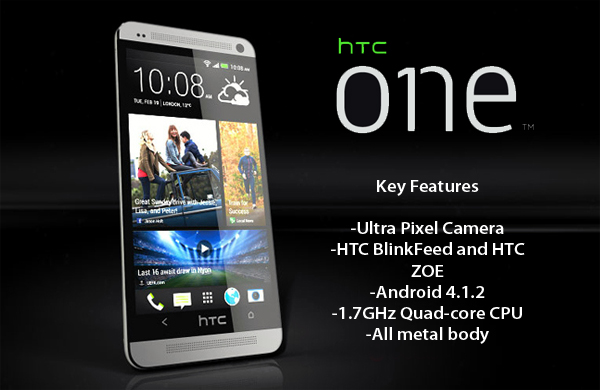Hello everyone, after a month of hiatus, Tech Tuesdays on
TFL is back to give you the latest and trendiest tech topics in the face of the
internet. And this week, we’ll be talking about two of the hottest and most
talked about smartphones today – the HTC One and the recently announced Samsung
Galaxy S4.
Both phones aren’t officially available in the global market
yet, but both the HTC One and the Galaxy S4 have been pitted against each other
numerous time on various websites, blogs and of course in social networking
sites. So this week, let’s take a closer look at these two super phones so that
we’ll have an idea on what each handset provides to us consumers.
The HTC One is barely a month old since its launch last
February and yet a lot of people are already considering it as one of the best
smartphones released this year. And this is not that surprising as HTC has
delivered a phone that is not only pleasing to look at but is also jam packed
with features and software that leaves (most of)its competition in the dust.
In the display department, the One features a 4.7-inch Super
LCD3 capacitive touchscreen with a screen resolution of 1080 x 1920 pixels and
a pixel density of 469 pixels per inch. The screen is protected by Corning’s
Gorilla Glass panel technology.
In terms of performance, the HTC One runs on Android 4.1.2
Jelly Bean and is powered by a Qualcomm APQ8064T Snapdragon 600 chipset with a
1.7GHz quad-core processor with Adreno 320 GPU. There’s 2GB of RAM and 32GB or
64GB worth of on-board storage.
However, the HTC One’s crowning glory comes from the camera
department. In contrast with other manufacturers who try to outdo each other by
putting a camera with the most pixel in their devices, HTC is trying to set
their own bar by using a camera with “ultrapixels”. Basically the camera sensor
in the device can gather 300 percent more light than most conventional cameras
and yet retain the size of 4MP sensor.
A few other cool things to note about the HTC One are the
numerous features that the company has incorporated into the handset by means
of its HTC Sense 5. These include the HTC Blinkfeed, a news and social media
aggregator that is shown on the phone’s home screen, HTC Zoe which makes use of
the device’s camera to create a rich multimedia experience, and lastly HTC
BoomSound that utilizes the two front-facing speakers to deliver true stereo
audio for an immersive audio experience.
Another smartphone heavy weight to make its grand entrance
this quarter is the Samsung Galaxy S4. The phone made its debut at the
company’s “Unpacked” event in NYC
last week. And although a lot of people were sort of disappointed with the lack
of innovation in terms of design, Samsung still managed to get a hype out of
the event and out of the phone.
For starters, the S4 packs some serious muscle power with
its Exynos 5 Octa chipset that features two quad-core processors clocked at
1.6GHz and 1.2GHz respectively and a PowerVR SGX 544MP3 GPU. It also has 2GB of
RAM and will come in 16GB, 32GB and 64GB variants. The display on the S4 is a
5-inch 1080p Super AMOLED capacitive touchscreen with Gorilla Glass 3 panel.
The Galaxy S4 has a 13-megapixel rear camera and a 2MP
camera at the front, both of which are capable of capturing 1080p videos at 30
fps. And just like the HTC One, The Galaxy S4 features a number of nifty
software and apps that maximizes the use of its hardware.
These include dual camera recording which allows the phone
to use both front and rear cameras at the same time to record videos. There’s
also a host of other camera functions such as Sound & Shoot that lets users
record five seconds of audio before taking a shot and the Drama shot function
which allows the phone to take more than 100 shots in four seconds so that the
user can select the best captured images to composite in a single frame.
An eraser function (anti-photo bomb feature) is also present
to acts similarly with the Drama shot but allows users to remove any unwanted
elements in a photo. Furthermore, Samsung has tossed in a few other apps including
a host of “S” apps such as Samsung’s health-oriented app – the S health.
Other notable features include the Group Play which allows users
to use multiple phones as stereo speakers in sync, Samsung Home Sync and Smart
Switch for seamless data transfer among other NFC enabled devices, Samsung Knox
for BYOD (Bring You Own Device) users who want to compartmentalize their
phone’s content into personal and work and of course the much talked about
Smart Scroll and Smart Pause features that uses eye-tracking technology.
Both phones sport LTE Cat 3, and the usual mix of Superphone
basics including Wi-Fi 802.11 a/ac/b/g/n, Bluetooth 4.0, accelerometer, gyro
and proximity sensors, compass and HTML5 support to name a few.
So there you have it everyone. Which super phone do you
think is the better – The HTC One or the Samsung Galaxy S4? Share with us your
thoughts by leaving a comment below. You can also find us on Facebook, Twitter, Pintrest and Google
Plus. And please, don’t forget to subscribe to
our blog for more Filipino lifestyle stories.







